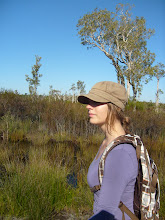As I write and draw this I’m sitting on my balcony in Sydney. It’s a
warm summer evening, the sun just went down, friends are having a chat in
the garden below and all seems peaceful. A cicada starts singing – it’s a
pleasant sound, reminding me of warm holidays spent in France. The bug must
have been a few gardens away. A closer one starts answering. And before I know
it, the tree next to my ear explodes in a shrill cacophony of noise. Gone are
the bird calls, gone are the voices from below, it is literally deafening. The
summer of the cicada has come to my back garden.
 |
| A bit of artistic freedom: this one does not sing in my garden but in South America. It's called the Giant Cicada (it's huge!) and is considered the loudest insect in the Western hemisphere. |
It is a bumper year for cicadas, both in the USA and here in
Australia. They haven’t emerged in large numbers like this for ten years (in
Australia, seventeen years in the US). Species with names like shady underworld
figures – masked devil, razor grinder, black prince – are prowling through the
suburbs of Sydney and the Blue Mountains in swarms.
 |
| The typical lifecycle of a cicada |
Why so many at the same time, you ask? Some of this can be
explained by the life cycle of these noisy bugs. Eggs are laid in slits in the
bark of trees. When they hatch a few weeks later the miniature cicada (called
nymph) falls to the ground and buries itself up to 2m deep. It is here that
they will spend most of their lifetime, feeding on the sap flowing through
plant roots. They grow, occasionally shedding their skin, until they reach
maturity. This underground stage can last any time from 9 months to 17 years(!), but most species will take 6 to 7 years. When they emerge, they shed their
skin one last time and enter adulthood. This stage is quite short compared to
the nymph stage, only a few days to a few months, typically 2 to 4 weeks.
It is not exactly clear why all cicadas decide to emerge at
the exact same time – but they do. It most likely has something to do with
environmental signs like increased sap flow in the tree roots indicating warmer
weather and more rain. This would explain why the cicadas were particularly
early this summer: Australia has had the mildest winter on record.
 |
| Studies of the only cicada I ever photographed - a Singaporian fellow from the Pomponia genus |
Emerging en masse does have its perks. The sole purpose of
the adult cicada is finding a mate and produce eggs. Finding a mate becomes
easier if there are millions of you buzzing around the same hectare. Cicadas
also use an interesting survival technique called predator satiation. The idea
is to overwhelm predators with such an overload they literally cannot eat them
all. Mind you, the birds will do their best. This also has its advantages; it
has been shown that in years like this birds produce stronger, healthier
broods.
 |
| The perpetrator in my garden: Cyclochila australasiae aka Green Grocer (you can see why). It is one of the only species adapted to living in urbanised areas and incredibly loud. |
Cicada swarms do very little damage. They are so
single-mindedly focused on reproducing that they do not eat. They are not
poisonous, they do not sting or bite. They don’t fly into your house and crawl
under your bed. The only real damage they can do is to your ears. It’s only
the male cicadas that sing, and when they do they can reach over 100 decibels. It’s
like a high-pitched airplane coming over. While they have the peculiar ability
to turn off their own hearing while singing, I do not. I think it’s time to get
some headphones.






